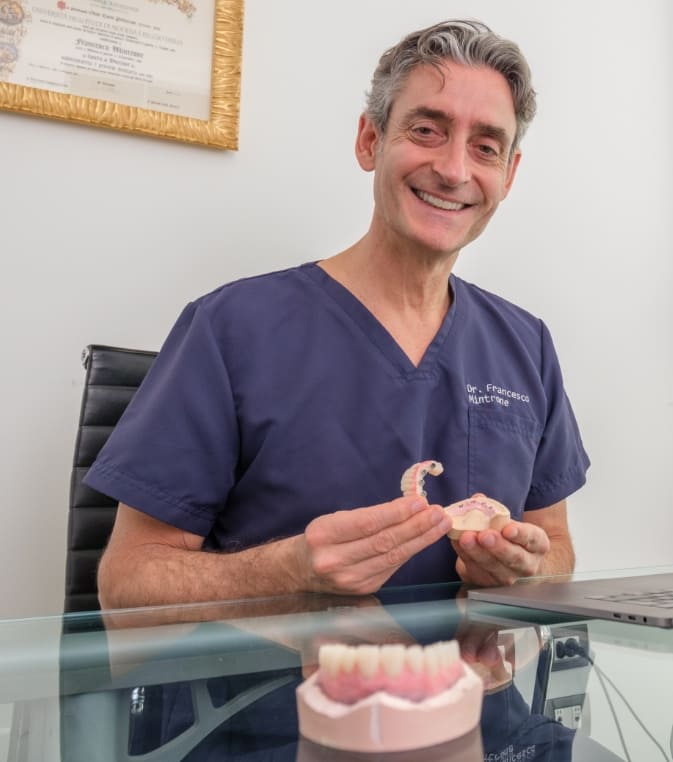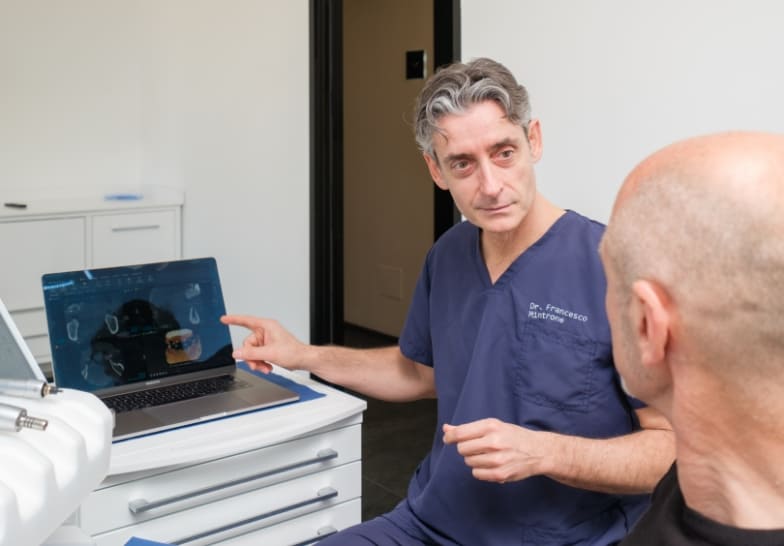RESTORATIVE DENTISTRY AND AESTHETIC PROSTHESIS
How important is a beautiful smile in everyday life? It is essential for social and work commitments; it affects our self-esteem and increases our confidence. However, there are many people who, for various reasons, have teeth they are not aesthetically pleased with: a situation that affects both the functionality and the appearance of their smile.
Thanks to aesthetic prosthesis, we can replace or rehabilitate missing or damaged teeth with high-quality and completely natural-looking solutions. Aesthetic prostheses are able to simulate the appearance of the original teeth in every way, blending with the neighboring teeth in terms of size, shape, and color.
Modern technologies applied to dentistry means being able to create prostheses that are practically indistinguishable from natural teeth, ensuring excellent aesthetic results and maintaining the naturalness of the smile.
Furthermore, dental prostheses completely restore chewing functionality, allowing you to regain the freedom to eat without discomfort.
The approach we adopt in our clinic perceives the patient as a whole and the aesthetic aspect of the smile as equally important as the functional result. That’s why we perform a careful Aesthetic Analysis on our patients using innovative technologies: the perfect dental prosthesis is the one that best adapts to the person’s facial features, enhancing their smile.
Aesthetic prosthesis: who and when?
The patients who benefit the most from the use of aesthetic prosthesis are:
- Patients with missing teeth, looking for a functional and aesthetically pleasing solution
- Patients with damaged or worn teeth due to bruxism or oral cavity diseases
- Patients with compromised teeth due to extensive fillings or failed interventions
- Patients who have suffered a significant dental trauma
- Patients who want to correct minor aesthetic defects of the smile, such as irregularities, stains, and slight misalignments
- Patients who are not satisfied with previous prosthetic interventions and want to replace incongruous elements with new generation prostheses designed to enhance the aesthetics of their smile
In all cases, aesthetic prostheses represent a valid solution to restore the functionality and appearance of natural teeth, allowing you to reacquire your best smile.

The advantages of Aesthetic Prosthetics:

Excellent resistance and long-term durability

Outstanding aesthetic performance in terms of shape, color, size, and natural transparency

Maximum biocompatibility of materials

Absence of allergic reactions
EXPLORE YOUR SMILE
Discover a new way of smiling and living your day, with confidence
The Different Types of Aesthetic and Dental Prosthetics
By aesthetic prosthetics metal-free aesthetic replacement elements made of integral ceramics that emulate the natural appearance of teeth.
The aesthetic prosthesis par excellence is a fixed prosthesis, as it is the only solution that can replace natural teeth while closely exhibiting the appearance of the original dental structure. It is called “fixed” because it is permanently affixed by the dentist to implants or natural teeth and cannot be removed by the patient without the help of a dentist. Convenience and stability are two additional advantages of fixed prosthetics, which provide unparalleled comfort compared to removable prosthetics.

Bridge: This structure is usually used to replace one or more missing teeth and is firmly attached to adjacent teeth. With the advances in surgical techniques now being applied to dentistry, bridges are becoming less commonly used in favor of more comfortable and less invasive solutions such as dental implants.
Crown: Also known as a cap, a crown covers a compromised natural tooth, fully restoring functionality and smile aesthetics.
Fixed prosthesis on dental implant: The implant is a small titanium screw inserted directly into the bone, onto which a crown is affixed. It is a convenient and perfectly stable solution that can replace a single tooth or even an entire arch using the four or six implant methodology. If you want more information on implantology, discover all the details HERE.
Aesthetic veneers: These are ultra-thin ceramic laminates applied to the front surface of natural teeth, designed to conceal imperfections in shape, proportion, or size. Thanks to detailed case studies at Dex, veneers can be applied with minimal preparation of the underlying tooth.
How does dental rehabilitation with aesthetic prostheses work?
The aesthetic-functional rehabilitation treatment always begins via a meticulous study of the clinical case, specific diagnostic tests, and examination of the patient history. Subsequently, the type of intervention to be undertaken (application of dental crowns or bridges on natural teeth, rehabilitation on implants, veneers) is defined based on aesthetic and functional needs.
It is important to emphasize that each aesthetic prosthesis is exclusively custom-made and personalized in terms of dimensions, shape, and color. We choose quality materials designed to last over time and have established close partnerships with international dental laboratories.
To create the perfect prosthesis for your smile, our clinic performs a thorough Aesthetic Analysis. This is a procedure through which the structural references of the face are studied, and the position, size, and shape of the tooth to be replaced is carefully evaluated. It is much more than a simple visual examination: thanks to state-of-the-art instrumentation, we capture a 3D scan of the face to analyze it thoroughly using dedicated software.
To create an aesthetic prosthesis that is a realistic match with the appearance of the patient, we conduct intonation tests, in particular the repetition of consonant sounds (such as the letters S and F) and study the patient’s facial expressions.
The computerized design of the prosthesis ends with a virtual simulation video in which the patients can preview the final result and a computer-generated representation of what their face would look like.

